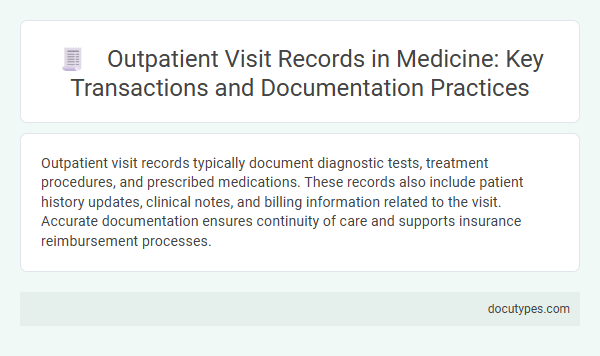Outpatient visit records typically document diagnostic tests, treatment procedures, and prescribed medications. These records also include patient history updates, clinical notes, and billing information related to the visit. Accurate documentation ensures continuity of care and supports insurance reimbursement processes.
Introduction to Outpatient Visit Records
Outpatient visit records are essential documents that capture detailed information during non-hospitalized medical encounters. These records provide a comprehensive view of your health status, treatments, and interactions with healthcare providers.
- Patient Identification - Records include basic demographic information to accurately identify the patient and ensure correct medical handling.
- Clinical Assessments - Documentation of symptoms, diagnoses, and physical examinations conducted during the visit.
- Treatment and Procedures - Details of prescribed medications, therapies, and any outpatient procedures performed during the consultation.
Importance of Accurate Medical Documentation
Outpatient visit records document various types of transactions including patient history, diagnostic tests, treatments administered, and medication prescriptions. Accurate medical documentation is essential for ensuring continuity of care, supporting clinical decisions, and facilitating insurance claims. You rely on precise records to maintain your health and receive appropriate medical interventions.
Core Components of Outpatient Records
What types of transactions are documented in outpatient visit records? Outpatient visit records primarily document patient encounters, including clinical assessments and treatment plans. These records capture essential transactions such as diagnostic tests, medication administration, and follow-up instructions, forming the core components for continuity of care.
Patient Intake and Registration Processes
| Transaction Type | Description |
|---|---|
| Patient Intake | Documentation of initial health information including medical history, current symptoms, insurance details, and consent forms. This process captures data essential for accurate diagnosis and treatment planning. |
| Registration | Recording of personal identification, demographic details, and contact information. This step ensures proper patient identification and streamlines insurance verification and billing processes. |
| Insurance Verification | Verification of patient insurance coverage and eligibility status. This transaction prevents claim denials and facilitates timely authorization for treatments and procedures. |
| Appointment Scheduling | Logging of appointment dates, times, and provider details. This ensures organized patient flow and optimized resource allocation within the outpatient setting. |
| Consent and Authorization | Documentation of signed consent forms for treatments or data sharing. This transaction protects patient rights and complies with regulatory requirements. |
Your outpatient visit records contain detailed information about these transactions to support efficient healthcare delivery and accurate medical documentation.
Key Transactions During Outpatient Visits
Outpatient visit records document various key transactions essential for accurate medical care. These include patient registration, medical history review, and diagnostic evaluations conducted during the visit.
Other critical transactions recorded are treatment plans, medication prescriptions, and follow-up appointment scheduling. Your outpatient record ensures continuity of care by capturing all interactions between you and healthcare providers.
Documenting Clinical Assessments and Diagnoses
Outpatient visit records primarily document a variety of transactions related to clinical assessments and diagnoses to ensure accurate patient care. These records play a crucial role in tracking the patient's medical history and treatment progress during each visit.
- Clinical Assessment Documentation - This includes detailed notes on patient symptoms, physical examination findings, and clinical observations conducted during the visit.
- Diagnostic Test Results - Results from laboratory tests, imaging studies, and other diagnostic procedures are recorded to support clinical decision-making.
- Diagnosis Recording - The clinician documents the identified medical conditions or diagnoses, often using standardized coding systems such as ICD-10 for consistency and billing purposes.
Accurate documentation of clinical assessments and diagnoses in outpatient visit records is essential for continuity of care and legal compliance.
Recording Treatments and Prescriptions
Outpatient visit records document various transactions, focusing primarily on recording treatments and prescriptions administered during the visit. Detailed entries include procedures performed, therapy sessions, and medication prescribed to monitor patient care effectively.
Your healthcare provider ensures that all treatments and prescriptions are accurately recorded for consistent follow-up and billing purposes. This documentation supports clinical decisions and facilitates communication between medical professionals.
Legal and Compliance Considerations
Outpatient visit records document transactions such as patient identification, diagnosis codes, treatment procedures, and billing information. Legal considerations require accurate and complete documentation to ensure compliance with healthcare regulations like HIPAA and to protect patient privacy. Your adherence to these standards safeguards both patient rights and institutional accountability in the medical record-keeping process.
Best Practices for Secure Documentation
Outpatient visit records document various transactions essential for patient care and administrative accuracy. Secure documentation practices ensure the integrity and confidentiality of sensitive medical information.
- Patient Demographics and Identification - Accurate recording of patient information prevents medical errors and supports secure access to records.
- Clinical Assessments and Treatment Plans - Detailed clinical notes and diagnostic results are securely documented for continuity of care and legal compliance.
- Billing and Insurance Transactions - Secure handling of financial data and insurance claims protects patient privacy and minimizes fraud risks.
What Types of Transactions Are Documented in Outpatient Visit Records? Infographic

